The History in detail
From the origins to our times
The first embryo of the future port of Sanremo probably existed since the time of the Saracen raids between the 9th and 10th centuries. Already in 1170 the city was able to arm a galley for the defence of navigation. During the Middle Ages there were many sailors from San Remo who sailed the seas with their sailboats and must have been very good if, according to an old Provençal saying " Li gens di San Remu navigoun san remu ", that is to say, they were able to dock with the sole aid of the sail, a manoeuvre that was not easy.
In 1130 the Genoese landed their soldiers in the port of Matuzzo to wage war against the powerful city of Ventimiglia. A little more than thirty years later some sailors from Sanremo would appear, together with other seafarers from the neighbouring towns, in a convention stipulated with sailors from Rome.
The relations between Jehovah and Sanremo have always been complicated from the beginning. While on the one hand, the Republic of Genoa welcomed the presence of sailors with whom it could arm the ships of its fleet, on the other hand, it endeavoured to avoid the presence of competing ports on its territory with all kinds of difficulties and misgivings, such as the prohibition to disembark goods that did not come from Genoa.
On 16 October 1199 a bubble was issued stating « ...We will not leave from S. Remo From the Calends of April to the Calends of October, the port will not be used to cross the high seas beyond Sardinia, or beyond Barcelona, without first touching the Port of Genoa, from where the port will not leave without having first obtained a licence from the Podestà, and the Consoli of the Municipality of Genoa, the helmsmen, interested participants, sailors, and all those who have to cross the sea over that wood, with the obligation for them to return to the Port of Genoa to unload it, even if they do not obtain a licence to do otherwise from the Podestà Consoli of the Municipality of Genoa. ...We Consuls, and the Podesta of San Remo, shall not allow, within the boundaries of our jurisdiction and district, to arm ourselves and to get out veruna Galera, or Corsaro wood, without in the first place all the seamen, helmsmen, and others interested in said wood, swear and give security not to do any insult to the Genoese, or to their distractors, and friends, obliged by convention, and pacts made with the Genoese themselves to have peace with us, ... »
Despite the limitations and hindrances, the first sure news about the existence of a port of call in Sanremo, however, dates back only to 1435, when the text of the municipal statutes expressly provides for the construction or renovation of a pier of boulders built near the Arenella beach.
With a resolution of 4th May 1533, Giovanni Battista Guglielmone and Antonio Asquasciato were elected massari of the port of Sappia, who were commissioned to examine the state of the pier and report on the works that were to be undertaken in the port area. In January 1558 the Town Council decided to entrust some competent persons with the evaluation of the expenses for the enlargement of the town's sea port, which was further enlarged in 1559 with the purchase of land that was to allow the landing of a larger number of ships, for whose defence it was decided to build a larger pier.
In 1575 the Parliament decided to allocate a three-year funding to further enlarge the city port, whose management was then entrusted to the Consuls of the Sea, the new officers of the municipal administration in charge of the coordination of maritime activities, first mentioned in July 1576, whose precise institutional tasks were fixed for the first time in the meeting of the Municipal Council of 13 February 1579. 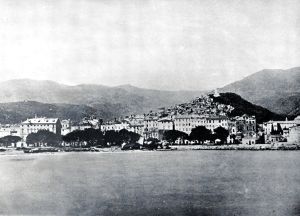 The decision to finance work to enlarge the port testifies, among other things, that the volume of commercial traffic in Sanremo must have been particularly flourishing already in the second half of the 16th century.
The decision to finance work to enlarge the port testifies, among other things, that the volume of commercial traffic in Sanremo must have been particularly flourishing already in the second half of the 16th century.
In order to recover revenue for port expenses, it was also decided on 10 March 1580, and a second time in 1596, to renew taxes on boats and transported goods, while at the same time the Town Council ordered the start of work on the Arenella pier by strengthening the reef with poles and planks so as to form caissons connected and buried at the bottom.
The Sanremo families themselves provided the necessary labour for these works free of charge, which were taxed for a few days of work according to the numerical and economic possibilities of each one. For this purpose, sequella shifts were established, from which the citizens could only escape upon payment of six money and eight denarii for each replacement day.
At the same time the municipal authorities, in order to provide for the purchase and processing of timber, iron chains, nails and other material necessary for the work, decided to introduce a tax for boats passing through the Sanremo port.
With the advent of the seventeenth century also began a very important period for the realization in Sanremo of a more suitable landing place for the new needs of the commercial and social life of the city. The community then turned more and more attention to the port area and its further development.
In the first fifty years of the century the local Parliament tried on several occasions to enlarge the city port without however achieving appreciable results, probably due to the lack of adequate technical and financial planning.
On 28th July 1600 the Town Council issued a resolution that imposed a sequel to the whole population: that is, it was imposed on all citizens to transport from the forest to the beach the timber necessary to complete the pontoon inside the port basin, used in numerous transport operations.
In 1605, the citizens of Sanremo sent a plea to Genoa, supported by the two deputies Giovanni Antonio Anselmo and Michelangelo Sapia, to obtain a loan sum necessary to complete the outstanding port works.
In the same year the quay of the Sanremo port was already 300 palms long (n.d.r. 1 Genoese palm corresponds to 0.248 mt, so 300 palms = 74.40 mt) with a height equal to 15 palms (3.72 mt) and, according to the project approved by the municipal authorities, it should have been extended by another 50 palms (12.4 mt), and, after one elbow, by a further 390 palms (96.72 mt).
The new construction would have also made it possible to create a safe shelter from the sirocco and to increase the seabed to 26 palms allowing the galleys to be moored. This last measure was probably adopted to obtain the necessary funding from the Genoese Senate as the new structure would have created an outpost for the Genoese warships in case of conflict with France. However, the projects of the Sanremo municipal administrators were abruptly interrupted by a violent storm that destroyed the new pontoon in the winter of 1605 causing serious damage to the rest of the port area.
However, the community did not give up its plans to enlarge the city port of call and already in 1608 the Parliament deliberated the reconstruction of the Sanremo port. On the same occasion the City Council asked the San Giorgio Office for a financing of two or three thousand shields to enlarge the port and the sending of an expert to Sanremo to evaluate the concrete possibility of building the new port structure. Two years later, in 1611, two engineers, Antonio Frugono and Bartolomeo De Luca, were commissioned to prepare plans for the reconstruction of the pier.
After a long period of crisis following the war between Genoa and the Duchy of Savoy in 1625, the Municipality of Sanremo resumed work on the port area with new vigour,  allocating the substantial sum of 26,000 lire as early as 1639-40 to carry out a major repair. This expenditure, however, represented only a small part of the huge reconstruction work on the pier, which was decided a few years later by Parliament and then completed in the three-year period between 1646 and 1648. The Sanremo municipal authorities in fact intended to build a landing place able to resist the action of the sea and, for the first time, they started a planning both of a technical and financial nature able to finally fulfil the wishes of the community.
allocating the substantial sum of 26,000 lire as early as 1639-40 to carry out a major repair. This expenditure, however, represented only a small part of the huge reconstruction work on the pier, which was decided a few years later by Parliament and then completed in the three-year period between 1646 and 1648. The Sanremo municipal authorities in fact intended to build a landing place able to resist the action of the sea and, for the first time, they started a planning both of a technical and financial nature able to finally fulfil the wishes of the community.
In order to ensure that the enterprise was successful from a technical point of view, the Town Council took care to contact one of the major construction companies of the time, while, as far as the financial aspect was concerned, the main concern was to achieve a relative managerial autonomy; the problem of relations with the capital was not even neglected, which was vital to obtain the necessary authorizations and the necessary contributions for the realization of the project.
On 21 February 1646 the Parliament took the first important decision, deciding to appoint a magistrate to make the new pier and to take a thousand pieces of royal shields from the Town Hall's cashiers. On the same day the Town Council appointed a special commission for the port, chaired by Antonio Fabiano and Giovanni Battista Bottino, and composed of the cashiers Paolo Battista Gandolfo and Michele Palmaro and the officers Giacomo Carlo, Gio Maria Fabiano, Germano Pesante, Giovanni Battista Borea, Giacomo Martini and Pier Francesco Sapia. The following 28th May the same Council charged Giovanni Battista Bottino to obtain the placet and the consent for the new pier from the Senate of the Republic, at the same time making the necessary agreements for its construction with the entrepreneur of Vado Ligure Ilario Gnecco. In order to cover the considerable costs of the pier construction, the Parliament authorised Bottino himself, by resolution of 11 August, to borrow 8,000 lire from the Municipality of Genoa. On the following 16th September, since a total expenditure of at least 70,000 lire per year for the new pier was estimated, the Town Council decided to impose a new "gabella" on the boats that frequented the harbour, reserving the possibility to withdraw the missing money from the other revenues of the Town Council.
Thanks to the substantial funds allocated by the Municipality, it was therefore possible to start the construction of a new masonry pier, no longer subject to wave erosion and able to guarantee safe mooring to the many boats that now landed daily in the Sanremo port; however, it was not limited to rebuilding the pier, but, in order to facilitate the loading and unloading of goods, a large area near the port was built to support the growing port activity, where warehouses and depots were built ready to receive all the products exported or imported by traders and sailors.  The work on the new pier continued with great speed until the beginning of 1647, when, due to a lack of funds, a further 4,000 lire was needed to continue the work, which was also slowed down by unforeseen technical difficulties that had arisen in the meantime. By now, however, the works were about to be completed, even though the Genoese authorities, fearing that the new landing place might make Sanremo a future rival of the capital in maritime trade on the Riviera di Ponente, tried to hinder the continuation of the works until the construction was stopped.
The work on the new pier continued with great speed until the beginning of 1647, when, due to a lack of funds, a further 4,000 lire was needed to continue the work, which was also slowed down by unforeseen technical difficulties that had arisen in the meantime. By now, however, the works were about to be completed, even though the Genoese authorities, fearing that the new landing place might make Sanremo a future rival of the capital in maritime trade on the Riviera di Ponente, tried to hinder the continuation of the works until the construction was stopped.
In fact, the Senate of Genoa decided to invoke the pretext that the works carried out were not those foreseen by the original 1646 project to freeze the financing and sent the Genoese architect Stefano Scaniglia to Sanremo to verify the truthfulness of the accusation.
As was to be expected, the architect Scaniglia supported the argument put forward by the Genoese government, arguing in his report that Sanremo could not afford a harbour larger than one that could accommodate a maximum of 25-30 boats. In order to be able to complete the work on the new pier, which risked suffering very serious damage if it was not completed quickly, the Sanremo Parliament then sent a plea to the Genoese authorities to allow the work to be completed.
The Senate of the Republic responded to the request of the Sanremo Parliament by ordering a substantial modification to the original project, which envisaged continuing the work for another 60 palms, so as to avoid the destruction of the top of the pier and the dispersion of the 15,000 scudi already spent on its construction. However, in execution of this ordinance, Parliament was forced to introduce new taxes in order to cope with the increased expenditure of the project thus approved.
At the end of 1647 the community of Sanremo had at its disposal no longer a small landing place able to offer shelter to a few boats, but a real port adapted to its growing maritime and commercial needs. The considerable increase in traffic volume and the large number of boats landing in the Sanremo port, however, began to create difficulties in manoeuvring in the port basin and along the docks, which led the Parliament to issue a special resolution requiring boats to leave the quay immediately after loading and unloading their goods. In the meantime, initiatives to further enlarge the port area followed one another, such as the one taken on 16 August 1648 by the Mayor of Sanremo Lorenzo Anselmo, who presented the Genoese government with a project to enlarge the port, which envisaged extending the quay for another 50-60 palms. The Genoese authorities then gave their consent to the start of work to improve the pier towards the end of the summer of 1648, denying permission to lengthen the pier within the terms requested by the mayor Anselmo.
In January 1654 the Parliament took the decision to stipulate a new contract with the impresario Gnecco, which was, however, frustrated by the simultaneous request for a large sum, corresponding to 10,766 lire, by the Government of the Republic, which intended to use it to finance the construction of the new walls of the capital and which, in fact, removed from the municipal coffers of Sanremo the funds already allocated for the new works in the port area.
However, the administrators of Sanremo were not so discouraged and on 5 April 1656 the Parliament issued another resolution that provided for the construction of a drop in the port, which would facilitate the loading and unloading of goods. On the basis of the relevant contract for the works, Parliament required the builder to comply with certain clauses, such as completing the work by September 1656, ensuring its stability for at least three years using good quality material and being liable for any breach of contract with all his assets and himself. In the meantime, the resumption of commercial activities prompted the community of Sanremo to desire a further extension of the downpour, as can be seen, among other things, from a letter sent to the Senate of the Republic by the Consuls of the Sea of Sanremo in 1660, in which the latter asked the Genoese authorities for permission to extend the downpour of the port by seventy palms, where the insufficiency of the seabed did not allow large ships to load and unload goods on the quay. In the five-year period between 1661 and 1666, the Parliament therefore tried to resume work in the port area, calling the entrepreneur Ilario Gnecco, who was then engaged in other works on the Tyrrhenian coast, back to Sanremo. Negotiations between the entrepreneur and the Municipality lasted a long time, however, both because many councillors did not consider him capable of carrying out a sufficiently solid work, and because Gnecco himself feared that a resumption of work in the Sanremo port would result in a new failure.
In the meantime, the resumption of commercial activities prompted the community of Sanremo to desire a further extension of the downpour, as can be seen, among other things, from a letter sent to the Senate of the Republic by the Consuls of the Sea of Sanremo in 1660, in which the latter asked the Genoese authorities for permission to extend the downpour of the port by seventy palms, where the insufficiency of the seabed did not allow large ships to load and unload goods on the quay. In the five-year period between 1661 and 1666, the Parliament therefore tried to resume work in the port area, calling the entrepreneur Ilario Gnecco, who was then engaged in other works on the Tyrrhenian coast, back to Sanremo. Negotiations between the entrepreneur and the Municipality lasted a long time, however, both because many councillors did not consider him capable of carrying out a sufficiently solid work, and because Gnecco himself feared that a resumption of work in the Sanremo port would result in a new failure.
It was only towards the end of 1666 that the negotiations seemed to reach a first conclusion thanks to the mediation of the patron of Sanremo, Angelo Pesante, who looked after Gnecco's interests in the city of Matuzzia. In fact, on 22 December of that year Gnecco wrote a letter to the Council to inform it that it was willing to provide a new project for the pier and to return to Sanremo in a short time. However, the agreement was not respected by the entrepreneur and on 29 April 1667 the Parliament ordered him to start the works within one month. In response, Gnecco did not move from Livorno and so he spent the whole of 1667 without anything being completed. With the beginning of 1668 negotiations resumed, also with other impresarios, which however did not lead to any positive result.
On 13th July 1668 the Parliament appointed a special commission to stipulate a contract for the improvement of the pier with Gnecco, allocating for this purpose the sum of 17,000 lire, increased to 18,500 four days later, provided that the entrepreneur committed himself to finish the work by the end of the year. On 31 August the technical terms of the contract with Gnecco, which would build a cliff 50 palms wide from the tip of the old pier to the new one, were finally fixed. A series of resolutions issued during the month of September, on the other hand, established the terms of payment of the builder, who would receive the sum of 5,000 lire divided according to the progress of the work.
The repair work on the pier therefore began in the autumn of 1668, but it does not seem to have proceeded particularly rapidly, also because the trade in the products of the Sanremo area fell sharply due to the frosts of 1668, 1670 and 1672.
It was only towards the end of 1672 that Parliament decided to allocate new sums for the dock factory, but it was nevertheless necessary to wait until 1674 to see an appreciable resumption of commercial activities. In 1677 the Parliament tried again to resume work on the port area by financing the expenses through the public sale of the anchorage gabella, purchased by a wealthy merchant from Sanremo.
In the first months of 1680, however, the port of Sanremo was by then reduced to a rather precarious state, mainly due to the heavy bombardments in August 1678 by a contingent of French ships; moreover, the fact that the shallow water allowed only small vessels to moor at the quay had practically paralysed commercial traffic, as few ships dared to enter the port to unload their goods there. Difficult negotiations resumed with the Genoese authorities to obtain authorisation to extend and repair the quay, an essential condition for the resumption of trade, which was the main and indispensable economic resource of the Sanremo community.
At the beginning of 1681 the Government of Genoa considered the requests of the Sanremo Parliament, which wanted to extend the quay by another 120 palms in order to prevent further burial of the port. The initial authorisation, issued by the Genoese Senate before transferring the file to the War Magistrate, however, modified the primitive project allowing the pier to be lengthened by only 50 palms. After examining the file, the War Magistrate then reported to the Senate on 9 January 1682 that an extension of the pier for another 100 palms would also help the Republic to repair its galleys in the event of a storm.
However, due to the rivalry with the town of Western Liguria and for fear of a dangerous increase in its maritime traffic, the Senate of the Republic, with an act dated 11th January 1682, decided not to ratify the advantageous proposal of the War Magistrate, thus forcing the community of Sanremo to renounce for the moment to build a wider landing place.
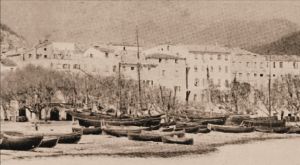 After a period of stagnation, the Parliament of Sanremo resumed the initiative and in January 1690 appointed Giacomo Borea from Sanremo to negotiate with a Genoese businessman the realization of a vast project for the enlargement of the port area. However, the negotiations did not follow and so, at the beginning of March 1990, the Sanremo builder Gio Francesco Martino was contacted, with whom the contract was stipulated on 24 July.
After a period of stagnation, the Parliament of Sanremo resumed the initiative and in January 1690 appointed Giacomo Borea from Sanremo to negotiate with a Genoese businessman the realization of a vast project for the enlargement of the port area. However, the negotiations did not follow and so, at the beginning of March 1990, the Sanremo builder Gio Francesco Martino was contacted, with whom the contract was stipulated on 24 July.
The contractor undertook to build a wharf 170 palms long, starting from the end of what remained of the previous works, with the clause, however, that the last 70 palms would be bound to the approval of the Genoese Senate. For its part, the Municipality guaranteed a financial coverage of 25,000 lire for the realization of the project. At the beginning of 1693, however, the works were still far from being completed and at that time the Parliament started a legal case against Martino to establish the causes and the nature of the damages caused by the non-performance of the contract.
While the works were at a standstill, in November 1694 a violent storm struck the coast, destroying a large part of the pier and dragging huge quantities of algae and sand, as far as Arenella, as well as many stones and numerous boulders torn from the pier. It was only at the beginning of 1697 that Parliament decided to allocate new funds for repairs to the port area, which was in such conditions that even the Genoese government had to recognise that new work was now urgent and indispensable. A commission from Sanremo therefore stipulated a contract with the entrepreneur Nicolò Firpo of Vado Ligure, who on 9 October 1697 started the realization of his project for the reconstruction and restructuring of the port. Also this time, however, the choice was not particularly happy for the default of the builder, who in the month of July '98 was exonerated from the task with the simultaneous request for damages and confiscation of property.
Towards the end of the summer of 1699 negotiations resumed to complete the work in the port area in the hope of providing the city with a suitable port: a new builder, Gio Battista Gerino from Genoa, was then contacted and went to Sanremo, evaluated the extent of the work to be carried out, reached an agreement with Parliament and finally bought the material sold at public auction by the previous contractor Nicolò Firpo.
The contract between Gerino and the Municipality of Sanremo, stipulated on 10 September 1699, provided, in addition to the extension of the wharf by 170 palms, a series of technical innovations that would have guaranteed greater solidity to the port; the cost of the entire work was finally estimated at 32,000 lire. Complications arose, however, due to the failure of the Sanremo administration to accept the four guarantors proposed by Gerino, which was a binding condition for the ratification of the agreement, and this led to March 1701 without the conclusion of the contract, until the City Council drew up a new agreement, in which the duties of Gerino were better specified.
According to this contract, the extension of the pier would be carried out by repairing for the first 70 palms the old work built by Martino and then ruined by the sea storms, while the next 100 palms would be reached through the laying of boxes until the completion of the 170 palms foreseen; greater care was also foreseen for the paving and the parapet of the quay, while the size of the cliff to protect the pier would also be modified. Finally, the community required the builder to start work on 1 April 1701 and complete it within two years. At first, however, Gerino refused to accept the conditions imposed by the Sanremo Parliament and returned to Genoa, but then decided to sign the contract, which was signed on 3 June 1701.
Thus work on the construction of the new port infrastructure finally began, but even this work was only partially carried out, and indeed after 1709, when yet another frost brought the city's agricultural production to its knees, which slowed down until it was almost completely suspended. Since then, Genoa was only concerned with imposing taxes, neglecting local problems.
Moreover, these works were the only ones carried out in the first seventy years of the XVIII century and, according to the surveys carried out by Colonel Matteo Vinzoni in 1753, they were carried out following the general lines of the contract stipulated in 1701.
In any case, the beginning of the real crisis of the port, the one from which the structure would no longer be able to leave except for short periods and thanks to lucky combinations, started in 1753, with the repression that followed the revolt against Genoa. The port areas were confiscated, extraordinary privileges were imposed and the ancient, laboriously acquired privileges were eliminated. The consequence was the end of the most flourishing period and the migration of local businesses, which at the time armed about one hundred and twenty boats. 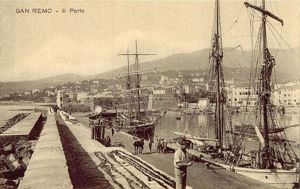 It was only in 1770 that, under political pressure from some foreign powers, the Genoese government was forced to demonstrate its interest in the economic recovery of the Sanremo district, of which the reconstruction of the port was the first and mandatory step.
It was only in 1770 that, under political pressure from some foreign powers, the Genoese government was forced to demonstrate its interest in the economic recovery of the Sanremo district, of which the reconstruction of the port was the first and mandatory step.
The commissioner general of Sanremo, Alessandro Carrega, who was the spokesman for these needs, then wrote to the government on 30th January 1770 to denounce the pitiful economic and social conditions in which the city found itself.
In the meantime, the people of Sanremo began to raise the necessary funds to finance the port works, knowing that if they did not find them, the Genoese government would immediately stop all practices. The municipal authorities then proposed to commissioner Carrega to transfer to the port the sum that Canon Gian Luca Fabiani had left for the construction of a collegiate church and some pious works with a will dated 23 February 1680, which had no longer found practical execution.
In 1770, in fact, the Fabiani lineage was almost completely extinct and only the families of the notary Lorenzo Cesarea, resident in Porto Maurizio, and that of Pietro Francesco Oreggia, who immediately agreed to renounce his part of the inheritance, which could thus be used for the reconstruction of the port, could benefit from the legacy.
Despite Caesarea's firm opposition, the other recipient of the bequest, who, living outside, was not interested in the problem of the Sanremo port, the Genoese commissioner approved the request for the transfer of the funds, well aware of the great political advantage this would have for the Republic, which could thus demonstrate to the European courts, always hostile to Genoa for the ferocious repression of the Sanremo revolution, its strong will to work for the economic and social well-being of the city.
On 8th July 1770 the engineer Domenico Policardi arrived in Sanremo with the task of quickly carrying out a project for the reconstruction of the city port. In the report sent to the Genoese government, engineer Policardi identified the cause of the filling up of the port in the construction of the Santa Tecla fort, which had blocked an opening at the base of the pier from which the arenas had previously come out. This filling had in fact demoralised the Sanremesi, who had not repaired the pier for many years.
The last 120 palms of the pier were now reduced to a pile of stones scattered under the surface of the water, and even the jetty of rocks at the top of the pier had been completely destroyed.
Policardi then proposed to build a double row of poles 20 palms long, which would have to be planted in the seabed for a depth of 14 palms; this double row, extended towards the sea, would then have to form a small moletto in the harbour for small ships and to repair the beach, where the boats could be built or repaired.
The Genoese engineer also planned to build a pier with a lockable opening, to allow the exit of the arenas in case of storm, and to build three boxes 100 palms long, 36 wide and 24 high to be placed in the immediate vicinity of the pier. Finally, the work would have required the employment of 150 masters and 550 labourers until the autumn of 1771. 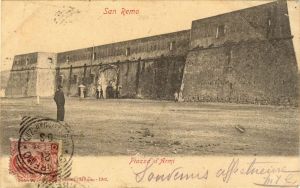 However, in presenting the government with a report that recklessly attributed the ruin of the port of Sanremo to the construction of the fortress of Santa Tecla, expressly desired by the government itself, Policardi indirectly caused the dry rejection of the project by the Giunta dei Confini, which closed it without even admitting its discussion in the Senate. Moreover, the Sanremesi still did not have enough money to subsidise the work, while discussions on the feasibility of using the Fabiani bequest helped to postpone any initiative.
However, in presenting the government with a report that recklessly attributed the ruin of the port of Sanremo to the construction of the fortress of Santa Tecla, expressly desired by the government itself, Policardi indirectly caused the dry rejection of the project by the Giunta dei Confini, which closed it without even admitting its discussion in the Senate. Moreover, the Sanremesi still did not have enough money to subsidise the work, while discussions on the feasibility of using the Fabiani bequest helped to postpone any initiative.
On 2 August 1779, the practice of the port was then proposed again by the new Commissioner General, who denounced in an alarming letter sent to the Genoese authorities the state of total abandonment and ruin of the Sanremo port of call, where in the last few years no less than seven ships had been shipwrecked, thus totally losing their crew and cargo. A few months later, a deputation of Sanremesi went to Genoa to inform the Government about the sad situation of the city due to the decadence of trade, the destruction of the pier and the impracticability of the beach, which were extremely impoverishing the city's economy.
In the meantime, a commission of Sanremesi technicians began work on the project for a new port. The project, which was perhaps a little too daring, involved the almost total abandonment of the stretch of water protected by the old piers and the excavation of the entire area behind the Santa Tecla fort to allow the ships to be sheltered in the dock thus obtained.
The proposal was then referred to the engineer Gerolamo Gustavo, sent by the Genoese authorities to Sanremo in 1780, who, however, immediately discarded it and set to work immediately afterwards to draw up the project for a new pier that would use what was left of the old one.
Gustavo, immediately recognised the great importance of the Sanremo port of call not only for the city itself but also for the general navigation of the entire Riviera di Ponente, proposed to lengthen the pier by 250 palms beyond the extreme tip of the rocks, to clear the arenas from the inside, to build a downpour in front of Piazza Sardi and to embank the torrents to the east and west, which, due to the cutting of many trees in the immediate hinterland, brought a lot of earth and debris to the valley.
However, as soon as the Genoese engineer announced the results of his study on the port, the main local authorities responsible for the construction of the port works expressed their deep disappointment at the project presented by the Genoese engineer, which clearly came to light in the letter sent on 1 July 1780 to the Genoese government by the Sanremo deputies for the practice of the port.
In this letter, the deputies did not hide their dismay at the cost estimate set by the engineer Gustavo at 400,000 lire, which they hoped to raise by using the remaining funds from the Fabiani bequest, which had meanwhile increased to 180,000 lire because the notary Cesarea, who remained the sole usufructuary of the capital, had not yet spent all the interest.
The nobleman Tommaso Borea d'Olmo, interpreting the wishes of the citizens, assured the Genoese government that if it lent the missing 220,000 lire to the Sanremesi, the local patrons and sailors would gradually return them, paying interest at 3% plus a landing tax. The plea ended with an appeal to the authorities of the Republic to be pleased to abolish the financial burden of 15,000 lire per year imposed on the Municipality to support the Genoese contingent stationed in the fort of Santa Tecla.
On 26 April 1781 five of the six Elders and a representation of the Sanremo patrons gathered to examine the project of the engineer Gustavo, which was approved in its essential lines.
After another year of discussions, the works designed by Gustavo could finally be started in 1782, continuing until 1784 under the direction of architect Claudio Storace in place of Gustavo himself, who had been called to direct some repairs in the port of Savona.
First of all the arena was excavated, lying in front of the fort, and then, after the last ecclesiastical protests for the suppression of the Fabiani bequest, the west pier was repaired, which was extended by 250 palms, while the east pier was extended by another 50 palms; a lowering was also built for the mooring of the boats along Piazza Sardi and the embankment of the two torrents was improved to avoid the deposit of their debris in the stretch of water defended by the piers. At that time, Tommaso Pier Francesco Borea was in charge of administering the funds allocated to the harbour works, deposited on the Banco di San Giorgio, while a certain Ettore Figari from Genoa was in charge of collecting, on visible stretches signed by Borea, the sums needed to pay the suppliers of the material.
However, the work in the port area was interrupted in December 1784 due to a heavy storm, which caused serious damage to the port equipment and contributed to increase the desperation of the population, which had now placed all hope in a rapid reconstruction of the port. Part of the funds allocated to the port works were then used to renovate some parts of the church of San Siro, including the façade and the dome of the bell tower, which were rebuilt in baroque forms according to the prevailing taste of the time. Meanwhile, on 4 January 1785, the Elders of Sanremo wrote again to the government of Genoa to obtain authorisation to resume work on the port area as early as next summer.
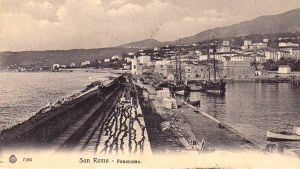 The government, however, did not seem to be very willing to meet the Sanremo's requests and in fact gave permission to carry out only a few minor works, such as the installation of a crate in the roadstead in front of the port in August 1785. Later on, the Genoese government accepted the request of the administrators of Sanremo to have their fellow-citizen Francesco Maria Gaudio, an eminent mathematician who taught at "La Sapienza" University in Rome and in those years lived in Genoa because the Genoese authorities called you to study the sea currents of the Ligurian Gulf.
The government, however, did not seem to be very willing to meet the Sanremo's requests and in fact gave permission to carry out only a few minor works, such as the installation of a crate in the roadstead in front of the port in August 1785. Later on, the Genoese government accepted the request of the administrators of Sanremo to have their fellow-citizen Francesco Maria Gaudio, an eminent mathematician who taught at "La Sapienza" University in Rome and in those years lived in Genoa because the Genoese authorities called you to study the sea currents of the Ligurian Gulf.
Gaudio then returned to his hometown to stay there for some time, the first time in the autumn of 1787 and the second time in the summer of 1789; during these visits he was able to study the situation of the local port well and was able to convince the Genoese government, through an acute and detailed report on the conditions of the Sanremo port, to grant the necessary authorisations for the continuation of work in the port area.
In the report presented to the authorities of the Republic, Gaudio first of all criticized the width of the port's mouth, measured in about 900 palms, which in his opinion allowed too easily the entry into the sand and debris roadstead, and therefore proposed to lengthen the old pier by 400-500 palms in the direction of the new pier, thus determining an opening of the mouth of at least 400 palms, which should have prevented algae and sand from entering the port area.
For the next four years Gaudio advised the works, but they were abruptly interrupted in 1792 because the new pier, perhaps due to technical inexperience during its construction, was subject to disastrous cover-ups, whose responsibility was attributed to Gaudio himself, who was particularly distressed by this unfortunate situation, which came about despite all his efforts to complete the works in a positive way.
The works were therefore suspended and after having squandered so much money on useless modifications, at the end of the eighteenth century the port of Sanremo was in conditions of extreme neglect and degradation, which would have been finally improved only with the interventions carried out in the port area in the middle of the nineteenth century.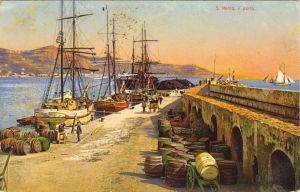 The Napoleonic age saw a renewed interest on the part of the French authorities in the conditions of the Sanremo port area, which were the subject of studies and research aimed at its further development. Among these studies stands out the detailed report drawn up in Nice on 15 June 1807 by the Chief Engineer of the Prefecture of the Department of Alpes-Maritimes Teulére, who had devised a vast project for the reconstruction and restructuring of the Matusian port area, specifying the related costs.
The Napoleonic age saw a renewed interest on the part of the French authorities in the conditions of the Sanremo port area, which were the subject of studies and research aimed at its further development. Among these studies stands out the detailed report drawn up in Nice on 15 June 1807 by the Chief Engineer of the Prefecture of the Department of Alpes-Maritimes Teulére, who had devised a vast project for the reconstruction and restructuring of the Matusian port area, specifying the related costs.
In this memoir, engineer Teulére first explained the general conditions of the city of Sanremo, which, according to his analysis, lay in a bay formed by Cape Verde to the East and Cape Pino to the West about 7,500 metres apart; the depth of the sea was 7 metres at the ends and 42 metres in the centre, the bottom was sandy and covered with a green carpet of algae, while the winds of the libeccio and scirocco, coming from the sea, were stronger than those of the land, which nevertheless brought sand and algae into the port.
The French engineer also noted that the majority of the inhabitants were engaged in seafaring activities; of the approximately 2,000 sailors from Sanremo, however, only 1,212 were regularly registered in the registration sheets, of which 140 were in the service of the State or prisoners of war, 670 were engaged in cabotage and trade and 402 were disabled or employed in fishing.
After having observed how such a tendency towards the sea on the part of the people of Sanremo made the presence of an adequate maritime port of call in the city of Matuzia indispensable, Teulére started to go over the history of the Sanremo port in brief, dwelling in particular on the long-standing problem of the burial of the port basin and the suggestions proposed to solve this problem.
At this point the French engineer began discussing his actual project, which involved the construction of a 137-metre long east pier in the direction of the west and ending with a 6-metre wide ballast road; the opening between the two piers was to be about 80 metres wide so that boats entering or leaving the port could manoeuvre freely and without hindrance.
In the Teulére project, Teulére also recommended that the dock be dredged carefully before starting work on the new pier, taking particular care to ensure that the boulders were not thrown into the sea in bulk, but lowered carefully and according to a pre-established plan. The engineer also recommended that the work should be suspended for a couple of years so that the whole work could settle down; at the end of the harbour works, a carriage road should be built with a large parapet to protect it from the winds.
Overall, the Teulére project would have led to the construction of a port covering an area of 20,000 square metres, which, according to the French engineer, would also have become a very important commercial centre, especially after the construction of the rolling stock between Ventimiglia and Piedmont, bringing great benefit to seafaring activities and the entire city.
Finally, the report was completed by a summary of the planned expenses, which amounted to 89,141 francs and 10 cents plus a sum for any unforeseen contingencies of 10,858 francs and 90 cents, bringing the total amount of expenditure to 100,000 francs. In a later note dated 14 July 1807, however, engineer Teulére pointed out that it would be necessary to preserve the wharf that had already been built in order to prevent it from being destroyed once again by a violent storm.
However, the project drawn up by Teulére was not immediately taken into consideration and it was only in 1809 that the first funding arrived, which allowed a series of contracts to be stipulated with various companies to finally start the works, which were then actually carried out without the problem of burying the roadstead, which still represented, at the beginning of the nineteenth century, the greatest obstacle to a stable and safe use of the Sanremo port of call.
In 1826 the Civic Administration of Sanremo returned to the question of the city port, which was in a state of serious neglect. On 15 May of that year, in fact, in the presence of the intendant Nota and the mayor Gismondi, the officers of the Magnifico Consiglio, both ordinary and deputies, as well as some members of the Port Commission, gathered in the town hall to discuss the problems related to the repairs to be carried out in the port area.
On this occasion the mayor's delegate, lawyer Pietro Paolo Giacini, read a long and detailed report on the situation of the port, in which he also suggested to the councillors how they should intervene to safeguard the port area.
Other members of the Sapia family, Rambaldi, Sartorio, Zirio, Margotti, the young Sanremo doctor Siro Andrea Carli, the future mayor of the city, and Marquis Tommaso Borea d'Olmo took part in the discussion that followed.
At the end of the meeting it was unanimously decided to mandate the Captain of the Maritime Engineer Machiavelli to draw up an expert report on the expenses to be incurred to carry out the necessary port works, also establishing that if the funds available for the financial year then in progress were not sufficient, the difference would be taken from the next budget for the year 1827. Finally, it was decided to send a plea to the President of the Admiralty to entrust a superior officer of the Maritime Engineers of his confidence with the task of inspecting the Sanremo coastline and then report on the nature and quality of the works to be carried out, drawing up a general estimate of the expenses necessary to carry out the above mentioned works.
On the following 8th June the harbour's labour commission met, composed of the President, Captain Francesco Lauro, the Mayor of Sanremo Vincenzo Manuel Gismondi, the Marquis Borea d'Olmo, Angelo Capoduro, Giovanni Battista Zirio and the Vice Consul of Marina Carlo Giorni. During the meeting, President Lauro reported to those present on the great difficulties faced by the owners of small ships in launching and winging their boats and in finding berths and jetties suitable for loading and unloading their goods.
The Commission therefore agreed to request urgent intervention from the Government, and in particular from the Prime Secretary for Home Affairs and the Admiral-in-Chief Commander-in-Chief of the Regia Marina, to provide subsidies to finance repair work at the port. In the end, however, the only funds that were found for the port works were those transferred from the municipal budget and those coming from a popular subscription that in a few years reached the considerable sum of 70,000 lire.
These funds made it possible to carry out some works, which had to be almost certainly limited to ordinary administration, such as repairing the breakwater and throwing some rocks into the sea. The new maritime regulations, issued on 24th November 1827, finally promoted Sanremo as a Class IV port together with the ports of call of Vado Ligure, Camogli, Lerici and Portovenere. In November 1836 the Town Administration decided to finance the works in the port area by indicating a collection of oblations among the citizens, which closed on 23rd December 1838. The relative list, deposited at the Municipal Archives, contained the names of the 447 citizens who had contributed to the port expenses with a voluntary offer. In the following years, however, the large sum collected, including the interest accrued in the meantime, was spent to subsidise other works of public interest, so much so that no funds remained available for the port ones. In the meantime, in 1837, the King of Sardinia Carlo Alberto, after repeated insistence by the Municipality, had agreed to promote the port of Sanremo as a Class III sea port of call.
In November 1836 the Town Administration decided to finance the works in the port area by indicating a collection of oblations among the citizens, which closed on 23rd December 1838. The relative list, deposited at the Municipal Archives, contained the names of the 447 citizens who had contributed to the port expenses with a voluntary offer. In the following years, however, the large sum collected, including the interest accrued in the meantime, was spent to subsidise other works of public interest, so much so that no funds remained available for the port ones. In the meantime, in 1837, the King of Sardinia Carlo Alberto, after repeated insistence by the Municipality, had agreed to promote the port of Sanremo as a Class III sea port of call.
A few years later, in 1845, the new mayor, Stefano Roverizio, went to Genoa to confer with Giovanni Battista Chiodo, Major General and Director of the Maritime Engineering Department, in order to solicit the practice relating to the port of Sanremo, which had already been long overdue and then probably lost.
Major Chiodo then advised Mayor Roverizio to start the whole procedure all over again, also asking for an audience with Prince Admiral Ferdinand of Savoy to inform him about the matter and solicit his interest. Roverizio welcomed the council and asked for a meeting with Prince Ferdinand, who accepted and received him, therefore graciously assuring him that he would personally deal with the matter, at the same time begging him to give him a memorial that would deal exhaustively with all the problems related to the Sanremo port of call.
On his return to Sanremo, the mayor started the port's practice again and, despite the fact that he had encountered considerable difficulties in finding plans and drawings on the port area at the Municipal Archives, he managed to prepare an accurate memorial accompanied by all the necessary documents, which was immediately sent to Genoa.
In the meantime, a Commission chaired by Major Chiodo himself arrived in Sanremo in order to carry out an inspection, study a general plan and draw up a report on the works to be carried out.
The report, dated 30 October 1846 and entitled Special Observations on the Station and on the project concerning the port of Sanremo, foresaw the execution of two series of works, which would have involved a total cost of 430,000 lire.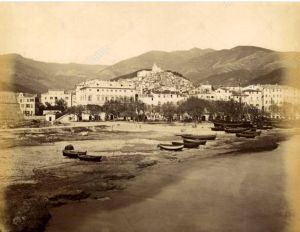 After having noted the disastrous conditions in which the port was in, the report proposed to restore the long pier to avoid its total degradation and to clear the arenas in order to allow the mooring of the boats that were then forced to be pulled ashore with an operation that jeopardized the hulls of the small tonnage ships with high consumption of ropes and ropes.
After having noted the disastrous conditions in which the port was in, the report proposed to restore the long pier to avoid its total degradation and to clear the arenas in order to allow the mooring of the boats that were then forced to be pulled ashore with an operation that jeopardized the hulls of the small tonnage ships with high consumption of ropes and ropes.
Having acknowledged the contents of the report, Mayor Roverizio proposed to the Board to meet the planned expenditure in two instalments, but the majority of the Board meeting, taken by enthusiasm, opted for the approval of the entire sum, without however taking into adequate consideration the financial difficulties that the Administration would have to face in order to find the necessary funds. A long bureaucratic process that would drag on for several years began, during which various projects were studied, appraisals and counter appraisals were drawn up and costs and all types of estimates were analysed in order to guarantee the best possible result. In the meantime, the ministerial authorities had not yet decided whether or not to grant a loan to the Municipality to subsidise port costs.
However, the situation was unblocked when the Minister of the Treasury, a personal friend of Mayor Roverizio's, managed to convince the officials of the Cassa delle Anticipazioni to grant the Municipality of Sanremo a loan of 120,000 lire, the first instalment of which was officially granted by King Carlo Alberto on 19 February 1848.
Shortly afterwards, the Town Council approved the loan and the related deed of indebtedness over 10 years, while the Mayor Roverizio sent back to the Genoa Maritime Engineering Department all the projects and plans relating to the port area so that they could be modified and the overall cost, considered too high, could be reduced.
The Mayor then went to Genoa for the fourth time to ask Major General Chiodo to modify the original project, drastically reducing the planned expenditure so that it would be in proportion to the city's financial resources and commercial needs.
A new appraisal was then drawn up and sent to the Superior Command of the Regia Marina by letter dated 16 September 1848, which envisaged a total cost of 257,693.97 lire; the appraisal was also accompanied by a plan of the Sanremo Station, signed by Major General Magliano, who in the meantime succeeded Major Chiodo, and approved by the Minister Secretary of State for War and Navy Della Rocca.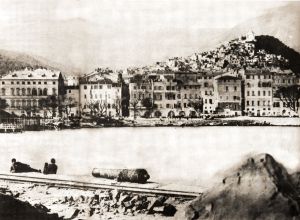 In the meantime, the Commission in charge of the port works decided to call one of the most valued entrepreneurs of the port of Marseille to Sanremo so that, given the deliberate works, he could advise the most economical way to carry them out or even assume the burden of carrying them out.
In the meantime, the Commission in charge of the port works decided to call one of the most valued entrepreneurs of the port of Marseille to Sanremo so that, given the deliberate works, he could advise the most economical way to carry them out or even assume the burden of carrying them out.
The member of the Commission Giuseppe Rambaldi, who went to Marseille, informed the mayor Giovanni Battista Grossi, who had taken over Roverizio in the meantime, that the city's public works contractor Elie Dussaud was willing to come to Sanremo on condition that the Commission would pay him the travel and other expenses for a total amount of 100 francs. After the Municipality of Sanremo had accepted these conditions, Mr. Dussaud went to the city of Matuzzo to carry out some inspections and draw up plans and projects for the port area.
On 20 February 1849, on his return to Marseilles, Dussaud sent the mayor of Sanremo a memoir, accompanied by a project, which illustrated his plan for the Sanremo port: it was to build a pier 112 metres long and 12 metres wide for a total surface area of 1,344 square metres, which would cost a total of 67,200 francs. In his memoir, Dussaud also highlighted the advantages for the loading and unloading of goods that would result from his plan to restructure the port area, which would cost a total of 355,000 francs.
The French entrepreneur's offer was, however, rejected, both because of its price, which was considered too high, and because the project proposed by the general manager of the Genio Marittimo Maggiore Magliano still remained valid.
The royal decree issued on 4 June 1849, by which the new King of Sardinia Vittorio Emanuele II, approved the preventive expenditure of the Genoa Maritime Engineers for the renovation of the port of Sanremo, also made a decisive contribution to the choice of the latter project. At that time, Major Magliano commissioned the Lieutenant of the Engineer of the Maritime Service of Nice, engineer Sassernò, to directly deal with the works concerning the Sanremo port of call.
Engineer Sassernò immediately set to work to draw up a contract, stipulated in Sanremo on 26 July 1849, signed by Sassernò himself and countersigned in Genoa on the following 3 August by Major Magliano, which provided for the complete reconstruction of the Sanremo port pier to be carried out at a price of 39,392.50 lire.
The contract also stipulated that the Civic Administration would transfer all its existing warehouses on the quay to the contractor, while the contractor would bear the costs of the contract, duties and taxes, as well as the provision of wagons, sledges, winches, wooden and iron levers, cardans and other tools, while at the same time undertaking to complete the work on the new quay within a maximum period of 18 months.
The stones needed for the pier would instead be quarried in the quarries chosen by the Civic Administration located on the land belonging to Emanuele Cremieux's wife, Marianna Moraglia and Antonio Muraglia. Finally, as far as the payments for the works were concerned, they would be paid in monthly instalments to be paid according to the progress of the work. To this memory the engineer Sassernò then attached three separate reports, accompanied by drawings and elevations, which better clarified the nature of the work to be carried out.
The first report, which concerned the works to be carried out on the east pier and other works concerning the port, was presented to the Sanremo administrators on 24 January 1850. In this study, Sassernò dealt with the ideal mouth of the port and the need to create an area of calm water within the port area eliminating any kind of silting up in order to reduce the undertow phenomenon as much as possible.
In the second report, the Lieutenant of the Maritime Engineer of Nice dwelt instead on the various systems for the construction of the piers and the kind of underwater works that should have formed the basis of the embankment; Sassernò then went on to describe the works to be carried out in the port of Sanremo, which he placed in three distinct areas: the east or inner pier, the west or outer pier and the downpours. The third and last report was instead dedicated to the subject of beaches and burials, which the engineer from Nice accurately described distinguishing the various types. 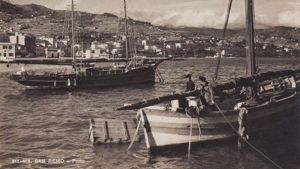 On 9 June 1850 the Royal Corps of Engineers of Nice then drew up the long tender specifications for the port of Sanremo, drawn up by Sassernò himself and composed of 109 articles, which were sent to Genoa for approval and countersigned by the Director General of Maritime Works Magliano.
On 9 June 1850 the Royal Corps of Engineers of Nice then drew up the long tender specifications for the port of Sanremo, drawn up by Sassernò himself and composed of 109 articles, which were sent to Genoa for approval and countersigned by the Director General of Maritime Works Magliano.
The document described in detail all the tender conditions for the works to be carried out in the Sanremo port in order to prevent the total ruin of the western pier, stop the sands entering the port area from the eastern side, extract the stones from the ruin of the western pier header from the sea bottom and start clearing the arenas that were deposited on the beach in front of the sea.
To these detailed tender conditions, Major Magliano attached a report, containing a series of modifications to the project for the extension of the pier and the restoration work on the port approved by Royal Decree of 4 June 1849, which basically consisted of a reduction of the port entrance to prevent the sea waves crashing against the east pier from creating an excessive backwash within the entire port area.
On 28th October 1850 the general intendant of Nice therefore ratified the contract for the works at the port of Sanremo for an initial amount of 100,000 lire, with no other funds available to the Treasury. On the following 5th November, the Municipal Council of the city of Matuzzo met to decide on the contract for the works in the port area. At the end of the meeting, chaired by the mayor Roverizio, the Council established that the payments provided for in the tender specifications would take place according to the progress of the works, with the deduction of the tenth to be paid for the balance four months after the final testing.
The total expenditure, foreseen in 100,000 lire, would finally be divided into three instalments of 22,500 lire for the years 1851, 1852 and 1853 and 32,500 lire for the year 1854. In the meantime, on November 2, Mayor Roverizio had communicated to the intendant of Nice the auction notice for the works to be carried out in the port. The following entrepreneurs had registered for the auction: Onorato Giordano, born in Villafranca but resident in Oneglia, Carlo Giordano, born and resident in Oneglia, Stefano Languasco, born and resident in Oneglia and Luca Becchi, born and resident in Sanremo.
On 20 December 1850 a meeting was held for the deliberation of the auction in the Council Hall of the Palazzo Civico in the presence of the mayor Roverizio and the councillors Borea d'Olmo, Gerbolini, Grossi, Bottini, Ameglio, Guarini and Bongiovanni. After examining in detail all the bids made by the various contractors, the municipal administrators considered the one proposed by Carlo Giordano to be the most advantageous, who was proclaimed the winner of the auction and to whom the mayor at the same time entrusted the contract for the works of the port for the sum of 88,000 lire. Giordano was then one of the most valued businessmen in the Sanremo district, where he had already contracted out several public works.
On 15 February 1851 the deed of submission of the entrepreneur with security deposit and mortgage in favour of the city of Sanremo for the realization of the port works was stipulated at the price of 88,000 lire. On this occasion, Giordano's father, Onorato, guaranteed for his son by mortgaging in his favour some assets located in Oneglia for a value of 97,000 lire.
On the following 22nd February, the general intendant of Nice approved and authorized Giordano's act of submission, giving the permission to the intendant of Sanremo to grant all the necessary permits.
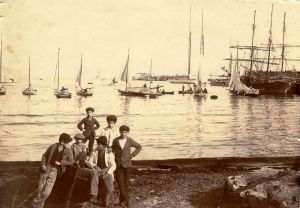 In March 1851 the work of the Impresa Giordano began, but it almost immediately clashed with the Civic Administration due to a series of problems caused by the work itself, including the transport of the boulders, many of which were abandoned along the roads or fell from the wagons carrying them, causing serious damage to the embankment and nearby land. In the following months, however, the works proceeded quickly, as attested by the numerous payment receipts regularly paid to Giordano by the administrative director of the works on behalf of the Municipality.
In March 1851 the work of the Impresa Giordano began, but it almost immediately clashed with the Civic Administration due to a series of problems caused by the work itself, including the transport of the boulders, many of which were abandoned along the roads or fell from the wagons carrying them, causing serious damage to the embankment and nearby land. In the following months, however, the works proceeded quickly, as attested by the numerous payment receipts regularly paid to Giordano by the administrative director of the works on behalf of the Municipality.
At the beginning of 1852, however, the stone quarry in the San Martino area, from where the boulders for the port were taken, was almost exhausted, so much so that Giordano proposed to the mayor to open another one in the Robino area. The businessman from Onegliano also declared himself willing to build the access road to the new quarry and to give it to the Municipality in exchange for the payment of an indemnity of 2,500 lire and the right of expropriation of the land where it was located.
The Municipal Council, after hearing the Mayor's report and considering Giordano's proposal acceptable, approved the allocation of the requested sum. Subsequently, however, difficulties arose regarding the exploitation of the new quarry, caused by the resistance of the priest Giovanni Carbone to the expropriation of his land, which would have been eventually resolved after a long dispute.
In the meantime, on 4th July 1852 a decree law had been issued which included the port of Sanremo in the 2nd Category of the ports of call belonging to the 3rd Class, matching it with those of Oneglia and Porto Maurizio. Towards the end of 1852 it was also announced that the government had decreed to give the city an extraordinary contribution of 8,000 lire for the works of the port, which in the meantime were proceeding quite quickly despite the continuous disagreements between the Municipality and the Giordano businessman.
At the end of 1853 the works were finally almost completed with the extension of 85 metres of the west pier, which at that time reached a total length of about 280 metres, the realization of the beach nourishment of the whole external cliff with an escarpment sloping southwards, the placement of large artificial blocks to defend the pier and the lengthening of the east pier, which was brought to a total length of 108 metres.
In the meantime, in the month of September, the direction of the works in the port area had passed from engineer Sassernò to provincial engineer Giovanni Battista Caneva in execution of a ministerial order that had exempted the Maritime Works Management from the service of the 2nd and 3rd class ports, to which the port of Sanremo also belonged, entrusting it to the engineers of the various provinces. 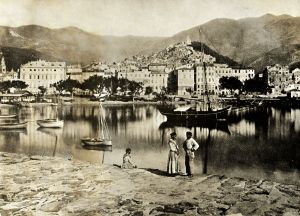 Shortly after the completion of the new port works, however, a furious sea storm, which lasted from 2 to 9 January 1854, caused serious damage to the west pier that had just been completed, causing a landslide inside the port area of about ten metres of ballast and damaging part of the pavement. To deal with these unforeseen expenses, the City Council, meeting in February, decided to introduce an extraordinary surtax, at the same time commissioning engineer Caneva to carry out a new project to extend the two piers.
Shortly after the completion of the new port works, however, a furious sea storm, which lasted from 2 to 9 January 1854, caused serious damage to the west pier that had just been completed, causing a landslide inside the port area of about ten metres of ballast and damaging part of the pavement. To deal with these unforeseen expenses, the City Council, meeting in February, decided to introduce an extraordinary surtax, at the same time commissioning engineer Caneva to carry out a new project to extend the two piers.
Lacking the necessary funds, the Administration then asked the Cassa Depositi for a loan of 120,000 lire and undertook to pay an interest rate equal to 5% of the total sum. In June 1854 another State contribution, issued by the Ministry of Public Works, amounted to 3,340.30 lire, while on 18 September the City Council established the procedures for repayment to the Cassa Depositi for the loan of 120,000 lire.
On 17, 18 and 19 October a series of other violent sea storms devastated the port area again, while a cholera epidemic broke out in the city, claiming numerous victims, especially among sailors.
In February 1855, the Mayor Roverizio wrote to the Minister of Works to request his intervention at the Cassa Depositi in order to obtain the loan of 120,000 lire already requested in June of the previous year. The situation in the port area was particularly critical, especially because the recent sea storms had destroyed a considerable part of the works that had just been completed.
In April 1856 the Town Council, chaired by the new mayor Antonio Bottini, returned to the port and examined in particular a long report on the conditions of the port presented by engineer Caneva. In this report the engineer of the province, after having mentioned the damage caused to the port by the sea storms of 1854, analysed the extent of the works to be carried out, consisting of some substructions to the south pier bastion, the restoration of the pavement and the laying of large stone blocks in the external ballast, for a total expenditure of 13,034.30 lire to be divided between the Municipality for 50%, the State for 25% and the Province for the remaining 25%.
The subsequent call for tenders for the assignment of the works was, however, deserted due to the meagreness of the sum allocated compared to the amount of work and the quantitative consistency of the technical means that the contractor would have had to sustain in order to carry out the work; it is probable, however, that this contract was also awarded to Impresa Giordano, which carried out small works in the port area during 1857. A few years later, in 1861, work was carried out for the beach nourishment of the reef, which involved a cost of 63,107.56 lire, divided equally between the Municipality and the government.
However, despite the work completed in the decades at the turn of the mid-19th century, the Sanremo port still did not offer sufficient guarantees for the anchoring of ships weighing more than 200 tons, allowing only small boats. The frequent breakers that broke on the eastern pier also caused serious damage to the boats moored inside the western pier.
To solve these problems, in 1866 the Town Council allocated the sum of 50,000 lire to carry out restoration works in the harbour and to launch a new project for its enlargement.
This project, which was drawn up by the new engineer of the province Giovanni Battista Parea, provided for the extension of the west pier by another 120 metres in order to shelter this area of the port from the strong winds of the Libeccio and Sirocco, but also this new plan for the redevelopment of the port area was no longer carried out.
The mayor Luigi Bongiovanni, who wrote a letter to all the deputies on 14 April 1869 urging the government to intervene on the port issue, wrote a letter to all the deputies in which the first citizen of Sanremo tried to interest them on the problems of the Matuziano port of call, recalling that the Municipality had already allocated the sum of 10,000 lire to subsidise the planned works. In another letter, this time addressed to the Minister of Public Works Mordini, the municipal administrators undertook to bind the budget for the years 1870-1871-1872 and 1873 for 40,000 lire in order to reach, with the already allocated 50,000 lire, the amount that would be ascribed to the city; this proposal was not accepted by the government either. The Town Council, in its meeting of 12 September 1870, decided to allocate the sum of 100,000 lire to the port, which the government had decided to allocate to the city as partial compensation for the expropriation of Corso Marina, where the new railway route was to pass, but this umpteenth project also remained on paper.
The Town Council, in its meeting of 12 September 1870, decided to allocate the sum of 100,000 lire to the port, which the government had decided to allocate to the city as partial compensation for the expropriation of Corso Marina, where the new railway route was to pass, but this umpteenth project also remained on paper.
In 1871, however, there was a renewed interest in the port on the part of the city authorities, who, through a public subscription, managed to collect 100,000 lire, immediately destined to restoration and improvement works in the port area.
During 1971, the Director General of the Ministry of Public Works, Martinengo, also took an interest in the matter. On 21 May, he wrote a letter to the Mayor of Sanremo to inform him that if the Municipality could prove that it really had the sum of 100,000 lire at its disposal and was willing to pay this sum into the State coffers, even in two instalments, he would take action in the Council of Ministers to have a law approved in a short time, which would have to regulate regulations concerning a certain type of public works with the participation of the government and local authorities.
Also in May, the Civil Engineering Inspector assured the mayor that he had deposited the project for the port of Sanremo, which had already been approved in April of the previous year, in the offices of the province, but, despite all these initiatives, in the years immediately following, work was no longer carried out in the port area due both to the lack of the necessary authorisations and the absolute unavailability of sufficient funding to subsidise the related expenses.
During the Asquasciati Administration, started in 1878, the issue of the port of Sanremo returned to the attention of the local political class.
The interest in the port area was stimulated by the letter sent on 1 April 1879 by the Director General of Public Works to Mayor Asquasciati, in which the high ministerial official informed the first citizen of Sanremo that a bill was being prepared, concerning the arrangement of the port of Sanremo, which would be submitted for parliamentary approval as soon as possible.
In the following December, the Maritime Society Assembly met, which prepared a long text addressed to the Municipal Council, in which the mandatory necessities of the port were underlined and a bitter criticism was made of the citizens of Sanremo, who were guilty of not caring much about maritime activities and of dedicating themselves to running "inns", demonstrating, however, a lack of confidence in the enormous potential of the emerging tourist phenomenon.
On the legislative front, on the other hand, it should be remembered that on 19 July 1880 a law was issued that provided for substantial public funding for the arrangement of some ports, including the port of Sanremo, for which the law authorised an appropriation of 200,000 lire, destined to finance the works of extension and arrangement of the piers and divided into three instalments, of which the first two, each of 50,000 lire, would be included in the budgets of 1880 and 1881, while the third, of 100,000 lire, would be included in that of 1882. 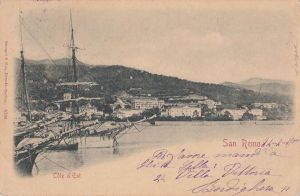 On learning of this appropriation, the Board of Directors of the Maritime Society then instructed the members Pesante and Molinari to go to Porto Maurizio to see the outline of the project drawn up by the Civil Engineers for Maritime Works. Contacted by representatives of the Sanremo association, the provincial engineer explained that the project envisaged a 23.20 metre extension of the east pier and 106 metres of the west pier. Having communicated these data to the assembly of the Society, the majority of the members agreed, however, to condemn the extension of the east pier, which was judged useless and harmful, arguing instead that it was necessary to allocate the sum provided for by law to carry out the extension, even a few metres, of the west pier alone.
On learning of this appropriation, the Board of Directors of the Maritime Society then instructed the members Pesante and Molinari to go to Porto Maurizio to see the outline of the project drawn up by the Civil Engineers for Maritime Works. Contacted by representatives of the Sanremo association, the provincial engineer explained that the project envisaged a 23.20 metre extension of the east pier and 106 metres of the west pier. Having communicated these data to the assembly of the Society, the majority of the members agreed, however, to condemn the extension of the east pier, which was judged useless and harmful, arguing instead that it was necessary to allocate the sum provided for by law to carry out the extension, even a few metres, of the west pier alone.
In the following years, however, despite an interminable series of meetings, assemblies and discussions, nothing concrete was done for the port area until, on 19 May 1888, an important meeting of the Town Council was held to discuss the arrangement of the port and its classification. During the meeting, chaired by Mayor Asquasciati, it was agreed to ask for the intervention of the President of the Chamber of Deputies, Giuseppe Biancheri, from Ventimiglia, to urge the government to allocate at least a small part of the 60 million state budget for Italian ports provided for in a bill then to the attention of Parliament.
Two days later the Council met again to continue the discussion on the port, during which the Councillor Pesante proposed to deduct from the loan, granted by the government for the damage caused by the earthquake of the previous year, the sum of 150,000 lire to be allocated to the port area; this sum, which increased with the help of the province would have risen to 750,000 lire, would have made it possible to extend the west pier by about 120 metres and to equip the port with all the most modern and efficient equipment capable of making it an important commercial port of call.
Pesante, who also held the position of Chairman of the Maritime Society, also asked that a Commission be appointed, made up of the Mayor and two people who were experts in maritime affairs but who were not members of the Council, to plan the best system for interventions in the port area. The Councillors Escoffier, Drago and Piccone were also in favour of the thesis of the great commercial port, while Councillor Calvi and engineer Marsaglia expressed reservations about the advisability of reversing government funds for an extremely uncertain enterprise, which, moreover, according to the mayor Asquasciati, was also excessively burdensome for local finances.
During the following part-session, the councillors who had proved to be the most ardent supporters of the creation of a large commercial port, reduced their claims and agreed with all the others that it would be better to limit themselves to using government funds to extend the west pier by 120 metres, postponing the more ambitious project of creating a large commercial port to a later date.
At the end of the meeting an agenda was then approved, with which a Commission was set up to consult with the Municipal Administration in order to associate the competent authorities of the Province and neighbouring Municipalities with the construction of a port capable of representing a suitable sea outlet for the Cuneo-Ventimiglia railway, and to request the government to provide the necessary funding for the construction of this port; on the same occasion the Council also instructed the Municipal Council to take care of the paperwork for the start of work to extend the south pier by another 120 metres.
In the following months the Commission for the port managed to obtain from the government the allocation of 250,000 lire for the extension of the west pier and another 50,000 lire for the extension of the east pier by 23 metres. On 2 April 1885 a law on ports, beaches and lighthouses was issued, with which all the ports of Class III, including Sanremo, were promoted to Class II, while the distribution of expenses was set at 60% to the State and 40% to the Province and Municipalities. With another law, promulgated on 14 July 1889, the sum of 300,000 lire was finally allocated for the extension of the west pier for a total length of 92 metres. Regarding this sum, the Councillor Pesante proposed to the Town Council to take out a loan of 300,000 lire and to pay the relative interest with the sum set aside to allocate it to the dowry of the Teatro Principe Amedeo. 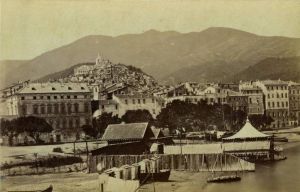 Another problem inherent to the port area was the concession, which the Municipality had requested from the State Property Office, of two areas of beach land located on the beach in the Arenella region, in order to build a bathing establishment and a public promenade, which was then actually built and named after Prince Federico Guglielmo, which still exists today under the name of Passeggiata Trento e Trieste.
Another problem inherent to the port area was the concession, which the Municipality had requested from the State Property Office, of two areas of beach land located on the beach in the Arenella region, in order to build a bathing establishment and a public promenade, which was then actually built and named after Prince Federico Guglielmo, which still exists today under the name of Passeggiata Trento e Trieste. 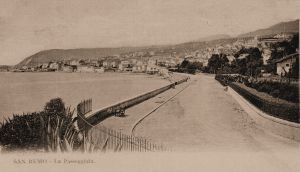 In fact, it was evident that the extension of the west pier, in addition to increasing the capacity of the port area and defending it from possible sea storms, would have constituted a valid barrier to protect the planned promenade, destined to cover the entire coastline of the city between the Arenella and the San Martino district.
In fact, it was evident that the extension of the west pier, in addition to increasing the capacity of the port area and defending it from possible sea storms, would have constituted a valid barrier to protect the planned promenade, destined to cover the entire coastline of the city between the Arenella and the San Martino district.
In the last decade of the nineteenth century important works were also carried out in the port area.
On 13 October 1892 the General Directorate of Hydraulic Works of the Ministry of Public Works issued a contract notice throughout Italy for the reef works for the extension of the western pier of the port of Sanremo for a total cost of 207,200 lire. The contract was then awarded to the public works contractor Fratelli Fabiani di Genova-Spezia with a contract signed and approved by the Ministry of Public Works on 19 January 1893.
The total sum made available by the government subsequently rose to 300,000 lire, 211,000 of which were allocated to a first contract, which consisted in the extension of the south pier for about 100 metres. The other 89,000 lire were instead destined to the east pier or possibly to the extension of another 20 metres of the west pier if the first hundred were not considered sufficient. 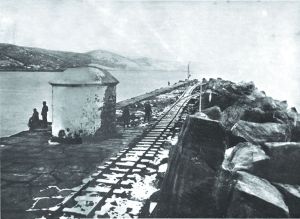 « It is stated in the acts of the Municipality that on 24 March 1893, the Town Council accepted the request of the company that was awarded the contract for the works at the port, in order to obtain " the faculty to place a narrow-gauge track along the road from the bridge over the Bernardo torrent to the west pier of the port, in order to transport the boulders needed for the works to extend the aforesaid pier. The transport would be done from the quarry located in the Pietralunga region, with steam-powered wagons, adjusting their speed at walking pace, during the whole day in the months from 1st May to 1st October, and with interruptions during the hours from 10 a.m. to 3 p.m. in the other months of the year. In the end, the remission of the road in the pristine state would be guaranteed, once the work has been completed.
« It is stated in the acts of the Municipality that on 24 March 1893, the Town Council accepted the request of the company that was awarded the contract for the works at the port, in order to obtain " the faculty to place a narrow-gauge track along the road from the bridge over the Bernardo torrent to the west pier of the port, in order to transport the boulders needed for the works to extend the aforesaid pier. The transport would be done from the quarry located in the Pietralunga region, with steam-powered wagons, adjusting their speed at walking pace, during the whole day in the months from 1st May to 1st October, and with interruptions during the hours from 10 a.m. to 3 p.m. in the other months of the year. In the end, the remission of the road in the pristine state would be guaranteed, once the work has been completed.
The Mayor adds that the means of transport to be put in place has the double advantage of speeding up the work and causing much less damage to the road" ».
(C'era una volta a Sanremo" by Giuseppe Silingardi)
For the lengthening of the west pier, the work on which began in 1893, boulders from the quarries of Capo Nero were used, transported as far as the railway road and then transferred to the pier by means of a temporary iron-vial line. The huge boulders were measured and weighed,
on a weighbridge set up at the beginning of the construction site, they were lowered into the water for their final destination. The largest block had a considerable weight of thirty-six tons.
("Sapore di Salsedine" by Marco Macchi)
The contractor worked expeditiously and within a year completed the work on the boulder casting and the quayside of the west pier. A total of 96 metres of pier were built, eight of which were destroyed by the violent sea storm that hit the Sanremo coast during the night between 14 and 15 January 1895.
However, since the remaining 89,000 lire had not yet been disbursed by the government, the work was subsequently interrupted, which risked bringing serious consequences to the work that had just been completed. Mayor Drago then went to Rome to the Ministry of Public Works and Mr Biancheri to ask for rapid intervention.
After consulting the ministerial officials, Drago sent a long report from Rome to the senior councillor Luigi Ameglio, dated 8 June 1894, in which the first citizen of Sanremo informed the City Council that the government was willing to favour the continuation of the work to extend the pier provided that the Municipality of Sanremo anticipated the cost of the work itself.
The Fabiani company, when asked about it, said it was willing to advance the 89,000 lire needed to continue the work. On 16 June 1894 the Municipal Council decided, subject to the approval of the Municipal Council, to accept the Fabiani company's offer, undertaking to pay the company an interest of 4% for a maximum period of two years. This resolution was approved by the Council on 19 June and therefore also signed by Mr. Orazio Fabiani on behalf of his company. The work could thus be resumed and ended with the extension of the west pier by another 30 metres, which by 1895 had reached a total length of 450 metres.
Once the Fabiani company's work was completed, the port area was discussed again, especially at the headquarters of the Società Marittima, whose partners Pietro Gazzano and Stefano Molinari proposed on 21 January 1898 a new master plan for the port area, which included an extension of the pier to the San Martino area. During this period, the Chairman of the Società Marittima Reforzo also proposed another project, which envisaged the construction of a pier almost at the height of the head of the west pier and perpendicular to it, in the direction of the Arenella, which would prevent the entrance into the basin of the arenas and would also constitute a valid barrier to the eastern winds.
This pier, called orthogonal, was considered very useful by the Government Commission sent specifically to Sanremo in 1898 to draw up a port works project for the realization of which the government allocated the sum of 360,000 lire by law n. 56 of 25 February 1900.  In these years the problem also arose of making the eastern part of the port more practicable so that it could be used as a landing stage.
In these years the problem also arose of making the eastern part of the port more practicable so that it could be used as a landing stage.
It was therefore proposed to build a large and comfortable masonry quay next to the eastern quay, which was to be used exclusively for the larger vapours; with this solution it would be possible to use the yard and the warehouses already built without disturbing the operations of the small cabotage boats.
A request in this sense was forwarded to the Ministry of Public Works, where, however, it was considered sufficient only to build two wooden wharves detached from the pier and set up at a distance to be determined in relation to the tonnage of the coal steamships that were to dock in the port's dock. The discussion on which solution to adopt, masonry quay or wooden pontoons, went on for a few years without any practical results.
In August 1899 the Ministry of Public Works in the meantime authorised the execution of repair and maintenance works at the west pier for the amount of 20,000 lire and after the last dredging works the port was ready to receive the traffic of the big steamships.
The results were not long in coming and already in 1904 more than seven hundred ships arrived, a good half of them steamships, for a movement of 25 thousand tons of goods and about five thousand passengers.
At last the port was safe and more and more ships were seeking shelter there. In those years the greatest movement was given by the steamships carrying coal for the gas stations of Sanremo and Ventimiglia, to which were added the sailing ships loaded with wine from Sicily. Other goods arriving in Sanremo were: wood, plaster, oil, cement and charcoal while they were exported: tiles, stones, wood, olive pomace, bricks.
This period of greater prosperity favoured the carrying out of other works such as the docking of the east pier, the construction of the warehouses of Mr. Escoffier's free port and the extension of another seventy metres of the west pier.
Despite this, however, at the beginning of the twentieth century, port traffic did not even reach 50,000 tons per year of goods transited and was carried out exclusively by sea; this situation did not allow for the aspirations of a large commercial port, as also demonstrated by the refusal of the State Railways on 20 March 1900 to install a connecting track between the port and the railway station.
On the other hand, at the beginning of the twentieth century Sanremo was chosen as a sea port of call by the German-American Shipping Company "Hamburgher-Nachrichten", which served the Genoa-Nice line three times a week with the steamship Cobra, and also as a venue for important international sailing regattas, which were already taking place on the nearby French Riviera, where they attracted the attention of many tourists from the wealthy foreign colony.
To complicate the situation there was the outbreak of the First World War.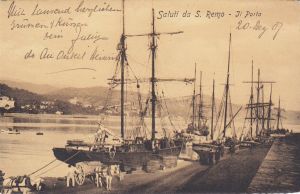 For the Sanremasca and Taggiasca sailors, as the Taggiasca sailing ships docked in Sanremo without a port of their own, the war worsened a state of freight crisis already widely present and due to the increasing diffusion and efficiency of steamships. During the war, Austrian submarines massacred unarmed sailing ships and practically brought about the end of an era.
For the Sanremasca and Taggiasca sailors, as the Taggiasca sailing ships docked in Sanremo without a port of their own, the war worsened a state of freight crisis already widely present and due to the increasing diffusion and efficiency of steamships. During the war, Austrian submarines massacred unarmed sailing ships and practically brought about the end of an era.
At the end of the conflict only five sailing ships survived in the port of Sanremo.
If we add road transport, in serious competition with cabotage navigation and the substitution of gas with electricity, and the consequent collapse of coal transport, it is well understood that the commercial movement of the port had to suffer a serious collapse in the immediate post-war period.
The trade of oil imported in drums, processed and bottled by the Escoffier Company in the warehouses of the free port, and then re-exported, survived.
Soon, due to the sanctions, this vein of traffic also dispersed and around 1935 the port of Sanremo ceased to be exclusively a commercial port of call.
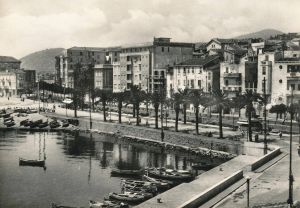 On 2 December 1936 the Municipality signed a contract with the entrepreneur Riccardo Parodi of Genoa, which was later ratified by the Ministry of Public Works with Decree no. 1726 of 30 March 1937, which provided for the rapid completion of a series of works in the port area for a total amount of
On 2 December 1936 the Municipality signed a contract with the entrepreneur Riccardo Parodi of Genoa, which was later ratified by the Ministry of Public Works with Decree no. 1726 of 30 March 1937, which provided for the rapid completion of a series of works in the port area for a total amount of
967, 230 lire; the works that were then carried out consisted in the enlargement of the forecourt located in the northern area of the port, the construction of a solid embankment of the San Francesco stream and the extension of the honour quay in front of the Harbour Master's Office, which at that time was commonly called the "yacht quay".
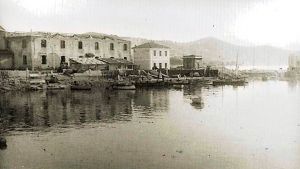
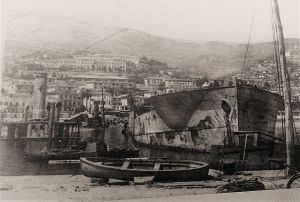 During the Second World War, the port, used among other things as a base for the vehicles of the Tenth Mas Flotilla, was subject to damage to port works on land and at sea.
During the Second World War, the port, used among other things as a base for the vehicles of the Tenth Mas Flotilla, was subject to damage to port works on land and at sea.
However, the war did not cause too much damage to the port structure except for the sinking of some medium-sized ships across the entrance to prevent the entry of enemy vessels into the dock.
After the war period, the first repairs were carried out and the port returned to a semblance of normality, in September 1948 the engineer Bartolomeo Corradi presented to the Municipal Administration an innovative project for a tourist port, which provided for the construction of a dry dock in the area where the Rowing Club was located and a brush in front of it equipped with a hammer head oriented towards the inside of the port, the extension of the breakwater for about 50 metres in the direction of the San Martino shore, the construction of a quay reserved for fishing boats along the last stretch of the west pier, the quay of the whole Pian di Nave area and the construction of a 225-metre long breakwater, sheltered from the mouth of the port, to protect the basin from the eastern winds, and in particular from the grecale.
Even the aforesaid work, whose total cost was estimated at 895,250,000 lire, despite the approval of many councillors and many simple citizens, did not find a practical realization remaining only on paper.
In the early Fifties the government launched the so-called " blue plan ", which provided for substantial public funding for Italian ports, including that of Sanremo.
Mayor Asquasciati then summoned to the Town Hall the representatives of the bodies interested in the port area, telling them that the practice of the port, already established in 1950 and carefully followed by the local parliamentarians, had led the Minister of the Cappa Merchant Navy to classify the port of Sanremo among those of "considerable tourist interest".
On the basis of this recognition, the Undersecretary for Public Works had informed the Municipality of Sanremo that 190 million had been allocated for a first batch of works on the port area which included the extension of the west pier by at least 100 metres and the beach nourishment of a large part of the external reef.
The Municipal Administration was then to participate in the expenditure with the sum of 50 million to be divided into two financial years.
The Civil Engineer of Maritime Works, chaired by engineer Attilio Natale, had also already been appointed to draw up the executive project for the work, which, once the work was completed, included the extension of the south pier by 350 metres with a slight deviation to the ground and the lengthening of the north pier by 250 metres.
In order to find the necessary funds to subsidise the works, the Civic Administration also promoted a popular subscription that raised more than ten million lire, as well as 2,000 signatures from citizens interested in sponsoring the company.
 In September 1955, the sea shore nourishment works on the cliff were carried out by Opere Marittime at a cost of 5 million lire, while the following month the first lot would finally be contracted out to Impresa Silbi di Roma, which came to the Municipality with a discount of 23.89% on the base figure of 190 million lire and committed to completing the works within eighteen months starting from November.
In September 1955, the sea shore nourishment works on the cliff were carried out by Opere Marittime at a cost of 5 million lire, while the following month the first lot would finally be contracted out to Impresa Silbi di Roma, which came to the Municipality with a discount of 23.89% on the base figure of 190 million lire and committed to completing the works within eighteen months starting from November.
The expenditure for the first lot was then divided into two instalments, one of 140 million to be paid by the State and the other of 50 million by the Municipality of Sanremo. During the following months 100 metres of complete extension of the foundation to the out-of-water works and 100 metres of quay in the final part of the existing pier were completed.
In 1957, a second lot of works was awarded to SILBI for 60 million lire, 15 million of which were paid by the Municipality. At that time, 37 metres of extension of the west pier were carried out in accordance with the directives of the Ministry of Public Works, which had prescribed that the work be carried out in all its parts for each of the lots.
In August 1971 the Town Council approved the project prepared by Martolini and Piras for a new marina, the future Portosole, which would be built on the Trento and Trieste Promenade on the left side of the Morgana.
Towards the end of March work began on the construction of Portosole in the stretch of sea in front of the bathing establishments on the Trento and Trieste promenade between the Morgana and the RAI antenna, despite the fact that the ministerial authorities had preferred the Valmarina project, which envisaged the construction of the tourist harbour along the current Promenade of Nations in front of the railway station.
In the end, however, the CNIS, Società Circolo Nautico Internazionale Sanremo, the contractor of the works, was able to obtain authorisation for the new structure in the area overlooking the Trento and Trieste promenade thanks also to the support of the municipal administration, and in particular the mayor Parise.
The port of Portosole, officially inaugurated in July 1977, would therefore have constituted one of the most modern and welcoming tourist landing places in the Mediterranean.
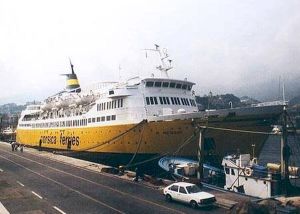 In the 80s of the last century there was also an attempt to establish in the port of Sanremo, a docking point for the ferries of a well known company that served between the ports of Liguria and Corsica.
In the 80s of the last century there was also an attempt to establish in the port of Sanremo, a docking point for the ferries of a well known company that served between the ports of Liguria and Corsica.
It worked for a certain period discreetly because it brought more people and therefore more commentry, but above all more vehicles.
In the end, however, after some problems that occurred during that period, the Company had to give up landing because the basin was not deep enough to allow an easy manoeuvre to dock and the large traffic flow caused a blockage for the whole port area.
(source: free elaboration from Andrea Gandolfo's text, "Storia di Sanremo", Sanremo ed. Colombo, 2000)
The history of port tourism and the transformation of the Port of Sanremo.
From the earliest antiquity the powerful of the land sailed for their pleasure and this leisure was reserved for princes and kings still in the seventeenth century.
It was in England in 1700 that the passion for the sea involved high society and started the development of pleasure boating and its related sport of sailing. At the end of the Napoleonic epic, the rich English society discovered the climate and beauty of the French Riviera, which was practically colonised.
In the evolutionary process, from an economy of survival to the tourism industry, Sanremo was also in the foreground for the foresight of legendary families such as the
Roccasterone, Asquasciati and Marsaglia.
The majestic yachts of the great bourgeois families such as the Rothschilds, Bennet, Vanderbilt and Gould were not to be missed in this binge of clear skies and bright sunshine. These were the first pleasure boats that visited the port of Sanremo and came to discover the Riviera so much praised by Ruffini and Doctor Antonio.
But the lack of quays prevented moorings and therefore the presence of visitors was fleeting and occasional. Our port was not a good shelter in case of storm.
It was only at the end of the century, after the extension of the pier and its quayside, that more and more yachts began to appear in increasing numbers.
In 1904, forty-five yachts arrived and their number increased steadily until the outbreak of the First World War.
In addition to Italian boats there were also foreign boats such as the Ossero of Archduke Charles of Austria. With the Alberto, and with the modest cost of three lire, it was possible to make a three-hour excursion in the gulf of Sanremo. Also the Violante cutter, put on sale by Captain D'Albertis, was stationed for some time in our port. This boat, with the name of Sphinx, participated in the sailing regattas of 1903.
In the early years of the century, the regattas contributed greatly to increase the tourist movement in the port and the interest in pleasure boating.
The decrease in traffic and the post-war crisis convinced most people that the future of the port of Sanremo was in the tourist sector rather than in the merchant sector. There were logically bitter controversies and debates that certainly did not contribute to the development of the port.
Only the Compagnia della Vela took part diligently and organised cruises and regattas that between 1926 and 1931 attracted dozens and dozens of motor and sailing boats to our waters. So the port exhausted the maritime traffic and the last cargo sailing ships disappeared, and it became animated by a puny tourism.
The golden age of the Côte d'Azur, in the light of which Sanremo was also moving, with its elite tourism and its splendid yachts, was over. For these reasons, in the thirties the port of Sanremo experienced a period of stagnation and despite the opening of the Ventimiglia-Cuneo railway line it was realised that Sanremo would not benefit from any goods traffic. The Second World War did not cause too much damage to the port structure except for the sinking of the ship Honor at its entrance.
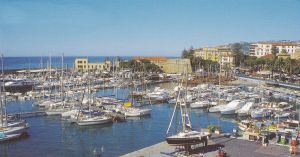 It was only at the end of the forties that the port finally became a tourist port of call and many boats returned to it, also thanks to the renewed commitment of the Sailing Company. Luxury boats such as the Sarina, the Dolphin and King Faruk's Fath-el-Bihar also reappeared.
It was only at the end of the forties that the port finally became a tourist port of call and many boats returned to it, also thanks to the renewed commitment of the Sailing Company. Luxury boats such as the Sarina, the Dolphin and King Faruk's Fath-el-Bihar also reappeared.
The pier was filled with trees and sails as never before. In the following years, the floating wharf of the Compagnia della Vela and the Club "il Luvassu" dock were equipped to meet the growing demand for berths, while the opening of a fuel station on the western wharf and a storage yard helped to improve services.
A floating dock also entered into service for the careening of the hulls.
In a few years the port was saturated and at the beginning of the fifties a global and definitive solution was devised to make dreams come true.
born from the projects developed in the early years of the century by Captains Gazzano, Reforzo and Goeta of the Società Marittima Sanremese.
But times had now radically changed and this time, thanks also to the financial effort of private individuals, a large independent port was built, designed solely for pleasure boats.
Not without controversy, slowness and difficulty it was built between 1974 and 1979 Portosole of our city.
(Source: "Sapore di salsedine" by Marco Macchi; images from repertoire)
Features of Portosole
The marina Marina Portosole Sanremo is located right in the centre of the City of Flowers, between the Sanremo municipal port and Punta San Martino. It is a port full of services, which enjoys an excellent position on the Riviera dei Fiori, acting as a "gateway" to the city of Sanremo.
It is a port full of services, which enjoys an excellent position on the Riviera dei Fiori, acting as a "gateway" to the city of Sanremo.
The port is protected by a breakwater, which offers shelter to its nine piers (in addition to the floating pier) from the comb-shaped layout.
The harbour has been designed to accommodate up to 804 boats at the same time, for boats with a maximum length of 90 metres.
The seabed is muddy and sandy, good tenors and has a depth ranging from 2.50 to 7 metres.
It offers its guests a continuous assistance service at the berth, the possibility of obtaining drinking water and electricity directly at the dock (equipped with lighting), a surveillance service and a service of issuing weather reports.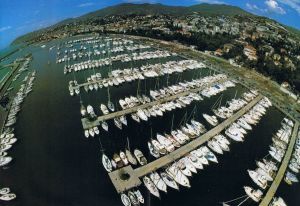 The port area also offers toilets and showers, a waste collection service, a laundry and sewage collection service, as well as a diving service in case of need.
The port area also offers toilets and showers, a waste collection service, a laundry and sewage collection service, as well as a diving service in case of need.
The area is well protected from winds from almost all directions, but be careful of any winds coming from the east.
As far as the shipbuilding and maintenance area is concerned, the marina is equipped with a slipway for boats, two travel lifts with a maximum capacity of 30 tons each, a slipway with a maximum capacity of 750 tons and some workshops for boat repairs.
In addition, there is a diesel refuelling station in the marina.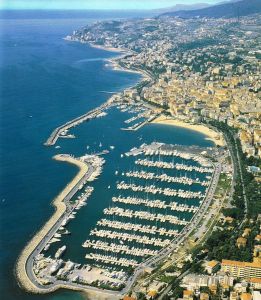 In addition to services related to the stopover of boats, the port hosts two shipyards, a brokerage centre, some nautical agencies, two sailing schools, a laundry for boats and some authorised points for on-board electronics.
In addition to services related to the stopover of boats, the port hosts two shipyards, a brokerage centre, some nautical agencies, two sailing schools, a laundry for boats and some authorised points for on-board electronics.
Moreover, in the port area you can find a restaurant and two bars (with a panoramic terrace overlooking the seafront), a car wash, a unisex beauty salon, an electric vehicle rental point and a bicycle rental point.
A commercial expansion project in Portosole involves the construction of a five-star hotel and a shopping mall, which will house shops of various kinds.
The particularly central location makes Portosole Sanremo an excellent starting point to reach many other tourist destinations in Italy and on the French Riviera.
Moreover, Marina Portosole Sanremo is home to the Tethys Institute, a body that studies cetacean specimens in the Mediterranean Sea.
(information source from the Marina di Portosole Website)




